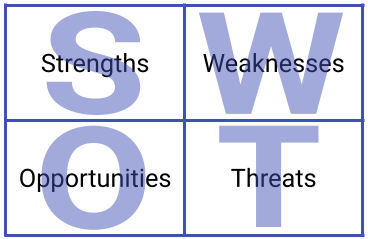 The humble SWOT analysis lists an organisation's Strengths, Weaknesses, Opportunities and Threats. It remains one of the most popular models in strategic analysis.
The humble SWOT analysis lists an organisation's Strengths, Weaknesses, Opportunities and Threats. It remains one of the most popular models in strategic analysis.
But its simplicity and power make it notoriously difficult to do well.
In this article, we will look at several techniques to help you do a better SWOT:
Brainstorm a quick and dirty SWOT
Brainstorming is probably the default way of doing a SWOT analysis. Whilst it is not the most robust approach, it should not be dismissed entirely. Particularly if you are looking for
- a very quick result or
- a starting point for further work using some of the other techniques described below.
You can improve your brainstorming by including a broad cross-section of employees and outsiders such as consultants, customers, suppliers and distributors. You can also make use of SWOT checklists.
Work in reverse order
An outside-in approach is almost always better than an inside-out approach for strategy. So it makes sense to start with the external factors - the Opportunities and Threats - before moving on to the internal factors - the Strengths and Weaknesses - that will allow you to exploit or avoid those opportunities and threats.
Start from your Business Model Canvas
A much more structured approach is to start with a Business Model Canvas or enhanced Business Model Canvas of your as-is or to-be organisation. Work through each element in each section of the canvas and do a mini-SWOT of that element. Evaluate your strengths and weaknesses regarding that element. And consider what trends might impact it positively (opportunities) or negatively (threats).
You don't need to have a long list of strengths, weaknesses, opportunities and threats for each element. However, the process of working through them in this way will yield a much more thorough SWOT analysis.
Start from your Value Chain Analysis
You can use a Porter's Value Chain of your as-is or to-be organisation in much the same way.
If you've already used a Business Model Canvas or enhanced Business Model Canvas to improve your SWOT, then you will already have considered your Core processes. So all that remains is to consider any Strengths, Weaknesses, Opportunities and Threats relating to your Support processes.
Use a PESTEL Analysis
A PESTEL analysis is a great way to identify a wide range of opportunities and threats your business faces. For each consideration identified in the PESTEL analysis, simply ask how it might help or hinder your organisation. You may also be able to identify threats and weaknesses by asking where your organisation is particularly well or poorly placed to respond to the trends in your PESTEL.
For a very thorough analysis, consider the possible impact of every item in your PESTEL analysis against every element in your (enhanced) Business Model Canvas or Porter's Value Chain.
Use a Porter's 5 Forces Analysis
You can use a Porter's 5 Forces analysis very much like you use your PESTEL analysis to identify opportunities and threats.
Use a McKinsey 7S
The PESTEL and Porter's 5 Forces analyses focus on factors outside of the organisation itself. A McKinsey 7S analysis looks at factors which are directly under the organisation's control. Consider the strengths and weaknesses for each of the 7 dimensions in this analysis. Also, consider the alignment between them as a source of potential strength or weakness.
Consider all 4 perspectives of the Balanced Scorecard
Consider the organisation's strengths and weaknesses from all 4 perspectives of The Balanced Scorecard: Financial, Customer, Internal Business Processes and Learning and Innovation.
Mine your Customer Analysis
If you've already used your (enhanced) Business Model Canvas to improve your SWOT, you will already have considered each of your customer segments. But don't stop there - scour all of your customer analysis for clues to what should be in your SWOT.
What do your customers say they value or don't value about your organisation's products and services, and how you deliver them? If they don't buy your products and services, what do they buy instead?
Mine your Competitor Analysis
Competitor analysis is a great source of insight into your organisation's strengths, weaknesses, opportunities and threats.
Which competitors are gaining or losing market share and why? Are their target markets shifting over time? What capabilities are they investing in, and what kinds of skills are they hiring? Which employees or customers are leaving you or your competitors and where are they going? What do your competitors say in their press releases and marketing material to persuade their investors and customers that they will be successful?
When thinking about strengths and weaknesses, you need some point of comparison. Strong or weak compared to what? Competitors (and substitutes) provide one point of comparison. (Customer expectations provide another.)
Look at it from multiple perspectives
Look at your SWOT from as many different perspectives as possible. Not just how you see it. But also how management, customers, staff (at different levels, in different types of roles), shareholders / owners, regulators, competitors, suppliers and distributors see it. Basically, look at it from the perspective of all of your stakeholders.
Be specific - avoid platitudes in your SWOT
When listing their strengths, most organisations say things like "our people are our greatest asset" or something similar. But don't settle for that. Ask: What specifically can your people do, that customers, distributors or other stakeholders value, that is different and better than your competitors? The more specific and quantifiable you can be, the better.
See also:
Back your SWOT up with detailed analysis
Usually, when you see a SWOT analysis it is in the form of simple lists of short statements of strengths, weaknesses, opportunities and threats. But don't stop there. For each statement, back it up with detailed evidence and analysis. What data support the statement? What examples illustrate it? The more detail you can provide, the more compelling your SWOT analysis will be.
Don't be afraid of including contradictory evidence and data. Strategy is a complex and often ambiguous subject. If it was easy, everyone would be doing it. Including contradictory evidence and data will increase your credibility. It will also allow stakeholders with contrary views to feel that they have been heard. Most importantly, it will help you to remain more alive to the possibility of your analysis changing as the situation evolves.
Your detailed analysis could include evidence and data about not only your organisation but also about your customers, partners competitors, etc.
Prioritise what you include in your final SWOT
Used correctly, these techniques will generate a vast quantity of information for your SWOT. A good SWOT analysis, however, is usually brief and to the point. It highlights only the absolutely key strengths, weaknesses, opportunities and threats in a way that engages, connects with and focuses key strategic decision-makers.
It is therefore important to prioritise your findings. Prioritise strengths and weaknesses by impact. Prioritise opportunities and threats by impact and likelihood. Don't be afraid to combine related items. Or to separate more complex items out into their constituent parts.
Once you've prioritised your SWOT analysis, exclude the least impactful or likely factors. Don't discard them, though. You may want to continue to keep an eye on them in case circumstances change and they become more significant again.
StratNavApp.com supports all of these techniques in a collaborative online environment. Why not try it for free right now and start producing a better SWOT analysis that makes a real difference to your organisation?
See also:
